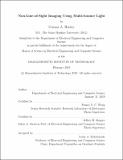Non-line-of-sight imaging using multi-bounce light
Author(s)
Henley, Connor A.
Download1102050128-MIT.pdf (6.566Mb)
Other Contributors
Massachusetts Institute of Technology. Department of Electrical Engineering and Computer Science.
Advisor
Franco N. C. Wong and Jeffrey H. Shapiro.
Terms of use
Metadata
Show full item recordAbstract
Non-line-of-sight (NLOS) imaging techniques produce images from light that has travelled from the scene of interest to the observer via indirect paths which typically include multiple reflections. Such techniques can be particularly useful when the direct line of sight between the observer and the scene is blocked. In this thesis we will explore two NLOS imaging techniques. The first is an occlusion-assisted imaging technique, which constructs images of hidden scenes by interpreting the patterns that are imposed on multiply reflected light by occluding objects. We will provide a conceptual and theoretical introduction to our technique, which uses a focused, scannable illumination source and a single-pixel, lensless detector. We will then present the results from an experimental implementation of this technique in a challenging environment. This will be followed by an analysis of a number of challenges that are commonly encountered in active, occlusion-assisted imaging scenarios, including single-bounce light rejection, inter-reflections, and asymmetries in measurement geometry. Finally, we will introduce a new NLOS imaging technique which uses the time-of-flight information in multiply reflected light to produce an unobstructed, line-of-sight view of a hidden scene. We will provide a conceptual introduction to the technique as well as a derivation of the physical model that underlies it, and will also discuss methods for visualizing the technique's output.
Description
This electronic version was submitted by the student author. The certified thesis is available in the Institute Archives and Special Collections. Thesis: S.M., Massachusetts Institute of Technology, Department of Electrical Engineering and Computer Science, 2019 Cataloged from student-submitted PDF version of thesis. Includes bibliographical references (pages 91-93).
Date issued
2019Department
Massachusetts Institute of Technology. Department of Electrical Engineering and Computer SciencePublisher
Massachusetts Institute of Technology
Keywords
Electrical Engineering and Computer Science.